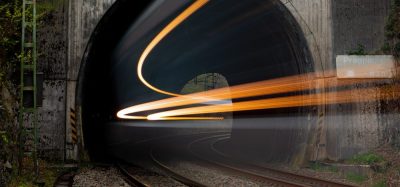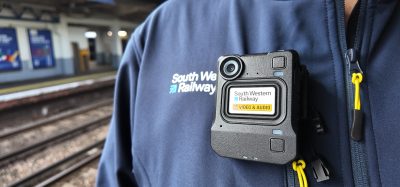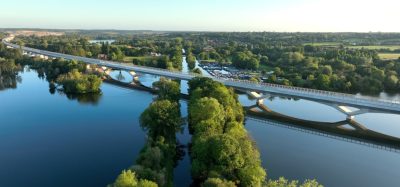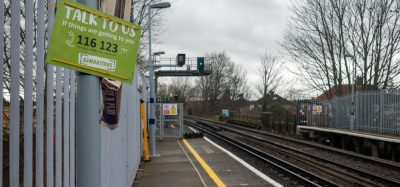Ensuring safety at Estonia’s level crossings
Posted: 17 July 2016 | Tarvi Viisalu (Estonian Railways) | No comments yet
As of today, the infrastructure of Estonian Railways Ltd (AS Eesti Raudtee) has 153 public level crossings. Out of these, 116 are equipped with automated traffic signals (ATS), 34 of which are in turn equipped with automated barriers. Out of the total 153 crossings, 37 are not regulated at all, meaning they are only equipped with traffic signs and no additional security equipment. Tarvi Viisalu, Chief Inspector of the Safety Department at Estonian Railways Ltd, elucidates on the measures in place and demonstrates the many improvements that have taken place to ensure safety at level crossings, as well as plans for future development.
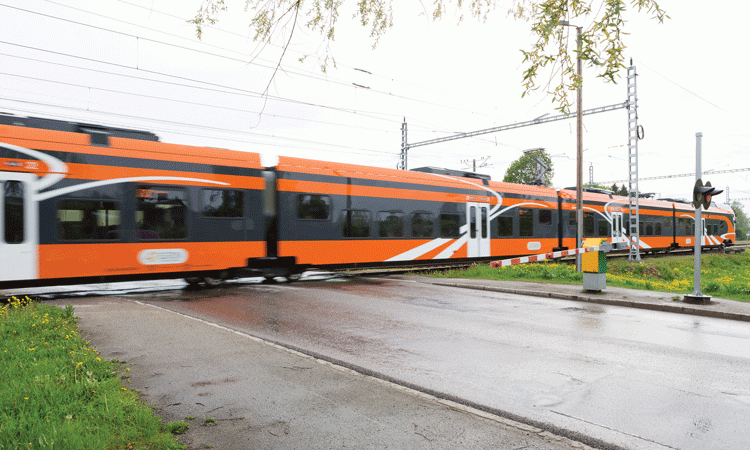

The requirement to provide all railway crossings with equipment is stipulated in the Republic of Estonia under Annex 4 of the Rules for Technical Use Of Railway, which divides the crossings into three different categories. The criteria for determining the category is the type of rolling stock that passes through the crossing as well as the vehicles that cross in a 24 hour period.
Category I crossings are generally situated in densely populated areas and have both automated barriers as well as traffic signals. Category II crossings are equipped with automated traffic signals and, where necessary, with barriers. As a rule, no traffic signals are installed at Category III crossings.
According to this same document, the 153 crossings of Estonian Railways Ltd are divided into categories in the following numbers:
- Eight crossings in Category I (with ATS and barriers)
- 39 crossings in Category II (with ATS and barriers where needed)
- 106 crossings in Category III (not regulated and without ATS).
The compliance of railway crossings to safety requirements is verified annually by the inspection committee of railway crossings, comprising the representatives of the Estonian Technical Surveillance Authority; local authority; Police and Border Guard Board; Road Administration and Estonian Railways Ltd. Where necessary, the category of a crossing is changed or other supplementary safety measures are implemented. Regular inspection and adjustment is carried out every two weeks. In addition, Estonian Railways Ltd regularly monitors activity on the crossings looking at the conditions and proceeds accordingly. By monitoring the actual use of the railway infrastructure they can develop traffic regulation technology when upgrading the automated traffic signals.
If it appears that the local circumstances (trees, terrain, visibility triangle from the road or any other obstacle) do not guarantee sufficient safety, it is possible to install additional traffic signals to the railway crossing in order to increase safety and draw the driver’s attention to the changing conditions (new and more quiet trains, variable speeds, traffic density, etc.).
This opportunity has been used repeatedly by Estonian Railways Ltd, providing several crossings with devices that, based on the traffic density, are required at the higher category level crossings. In this manner, the majority of the Tallinn–Tapa railway crossings have been supplied with equipment that is mandatory for Category I, i.e. traffic signals and barriers. Only 33 of the Category III crossings are actually not regulated; i.e. in order to increase safety, we have installed higher category safety equipment at 73 crossings in total (mainly ATS).
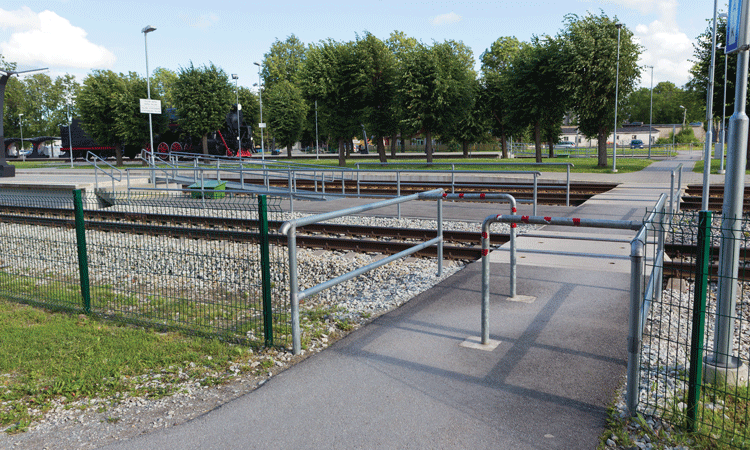

A typical ground-level pedestrian crossing in Tapa
Increasing traffic density leads to increased crossing modernisation
Over the last five years Estonian Railways Ltd has replaced 95 traffic signal systems with new-generation digital systems. In 2017 and 2018 we plan to renovate and equip all Estonian Railways Ltd crossings that currently have old-type traffic signals with modern automated traffic signals.
The new automated traffic signals have real-time monitoring systems. An alarm is triggered based on preventive measures that monitor tens of parameters and, when approaching an unsatisfactory threshold in any of the parameters, the alarm is sounded even before the deviation from the parameter might interfere with the functioning of the automated signal system, and certainly before any possible dangerous breakdown. The monitoring system of crossings is tracked in real-time by a dispatcher, who informs the maintenance staff immediately of any changes. At the same time the technical condition of crossings can also be monitored by traffic managers who, in case of an alarm, can immediately notify the managers of the rolling stock.
In 2009 an extensive renovation project of crossings was launched, which set out to replace the entire automated signal system of railroad crossings. Currently the new technology has been installed at more than 50 crossings. Even the automated signal system technology, which has not yet been replaced, corresponds to all norms and ensures the safe passage of the railway provided traffic rules are followed. The priority in renovating the crossings are those railway sections with high traffic density and multiple tracks.
In December 2012 renovation began of the railway crossings on the Tapa–Tartu line with a total of 28 crossings started. At 19 crossings the entire automated signal system was replaced with LED signal heads, the visibility of which is notably better for the drivers. Renovation of the crossings is a large-scale project, since replacement of the automated incandescent lamp signal system with LED traffic signals entails reconstruction of the entire existing automation system. Additionally, five of the renovated crossings were also equipped with barriers.
In 2014 the Tallinn–Tapa line was a priority due to high traffic density and its two-track railway, which increases the safety risks at the crossing, and where barriers were installed at all 14 railway crossings. The automated signal system was replaced at a total of 21 railway crossings in that year. In addition to the Tallinn–Tapa railway section, the automated signal system of crossings was upgraded with LED traffic signals at 15 railway crossings at the Tapa–Narva line. The Tapa and Rakvere crossings were already equipped with barriers at this section.
In 2015 the railway sections passing the city of Tartu – and partly also the automated signal systems on the Valga–Võru line crossings – were upgraded. A barier was installed at the Betooni street crossing in Tartu.
During the course of 2016 all railway crossings on the Tapa–Tartu section are planned to be replaced with Category I equipment (i.e. a traffic signal system and barriers), despite not all of the crossings on the line belonging to that category. This improvement is important from a safety viewpoint, given that the speed limit is to be increased to 135km/h on the Tallinn–Tartu line.
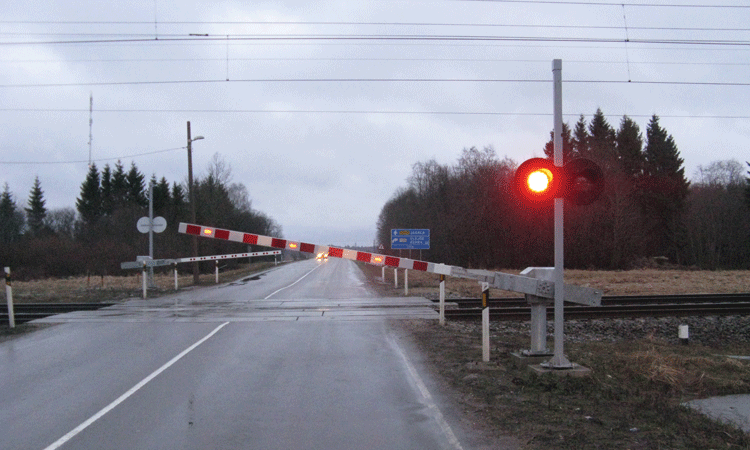

A new Category I level crossing on the Tallinn–Tapa line
Safety measures
Although investments in the railway crossings have improved the technical condition of crossings and reduced safety risks in using a public railway, the risk of an accident when crossing the railway has increased as a result of implementing the new Stadler Flirt passenger rolling stock; more dense traffic schedules; faster and smoother passing of the crossings; and more extensive use of smart devices and earphones that distract attention.
The key to preventing accidents is improving the behaviour of drivers through notification campaigns and making people aware of how dangerous railway crossings can be.
Considering the above, it is positive that in recent years the number of collisions involving a vehicle with a train at the crossings on Estonian Railway lines has decreased. In 2015 only two vehicle-train collisions occurred on level crossings on Estonian Railway infrastructure, with no injured parties. This is the best result of the last 21 years.
Considering the statistics of accidents at Estonian railway crossings it may be assured that there is no causal connection between the improvement of the safety equipment and the accidents. Above all, improvement of the safety equipment level is connected with continuous monitoring of the condition of crossings, since the local traffic environment and the risks arising from the same are changing in a dynamic way and accordingly one accident cannot be the main reason for increasing the level of safety equipment.
The most efficient way to attract the attention of a road user is the so-called active measure (ATS and barrier); still it is reasonable, pursuant to the local conditions (traffic intensity, visibility), to also consider measures with lower economic impact, such as speed limits; raised road surface markings; ensuring the necessary visibility corridor; closing the crossing and other measures that appease traffic. It is also wise to implement the respective measures in an accelerated manner; firstly at those crossings for which there is no legal obligation to install the safety equipment. With regard to limiting the speed, it is important to note that it is essential to bring the actual speed into conformity with what is requested and the ordinary speed limit sign might not be the most suitable measure for that.
Further measures
The planned higher speeds on the railway are the main reason why the Estonian Railways Ltd level crossing network has to be critically examined. There may be places in the railway network, developed over time, where the crossing has lost its relevance and is no longer playing an important role in respect of the road network. Accordingly, its closure would not have a wide social impact, yet would notably reduce the risks of crossing the railway. Taking into account the goal of both the country and the railway entrepreneurs to increase the traffic speed on the railway and to constantly contribute to railway safety, the need to improve the level of safety equipment may also arise in places where we have not yet managed to reach. Accordingly, it is of utmost importance that all rational arguments are taken into account when planning the improvement of safety equipment.
Estonian state authorities see increasing the attention of the driver immediately before reaching the railway crossing as a primary additional measure in ensuring railway safety. To foster attention, the following measures are to be implemented:
- Speed limiting measures for road users at those railway crossings where there is currently no requirement to reduce speed when crossing the railway
- On-going installation of structured road markings (so-called rumblers) and implementation of other measures that raise the driver’s attention
- Follow-up activities on improving the safety equipment of existing crossings
- Updating the safety assessments of crossings and increasing the level of safety equipment where necessary.
In addition to the above, the following measures are to be implemented in the near future:
- Implementation of a pilot project of cameras for catching drivers who cross the railway with prohibiting traffic lights
- Closure of existing crossings in cases where there are reasonable alternatives for traffic.
In cooperation with the state safety authority (Technical Regulatory Authority) Estonian Railways Ltd has discussed the expedience of decreasing the number of railway crossings and ascertained the proposals for closing railway crossings. Together with the Technical Regulatory Authority, negotiations for closing railway crossings have been initiated with local authorities. Estonian Railways Ltd continues with upgrading the safety equipment of crossings and installation of additional equipment where necessary. Cooperation has also been launched with the related authorities for the implementation of a pilot project of cameras to catch drivers who cross the railway with prohibiting traffic lights.
During the period of 1995-2015 there have been 232 vehicle-train collisions at railway crossings, in which 39 people were killed. In the last three years (2013-2015) there have been only 10 collisions, in which four people were killed. Accordingly, the average number of collisions in a year has dropped from 11 to three. So far this year1 one collision has taken place, in the course of which no people were injured. Improvements have certainly been made and we hope such statistics will continue to reflect this in the future.
Reference
- 2016 (at the time of providing this article).






